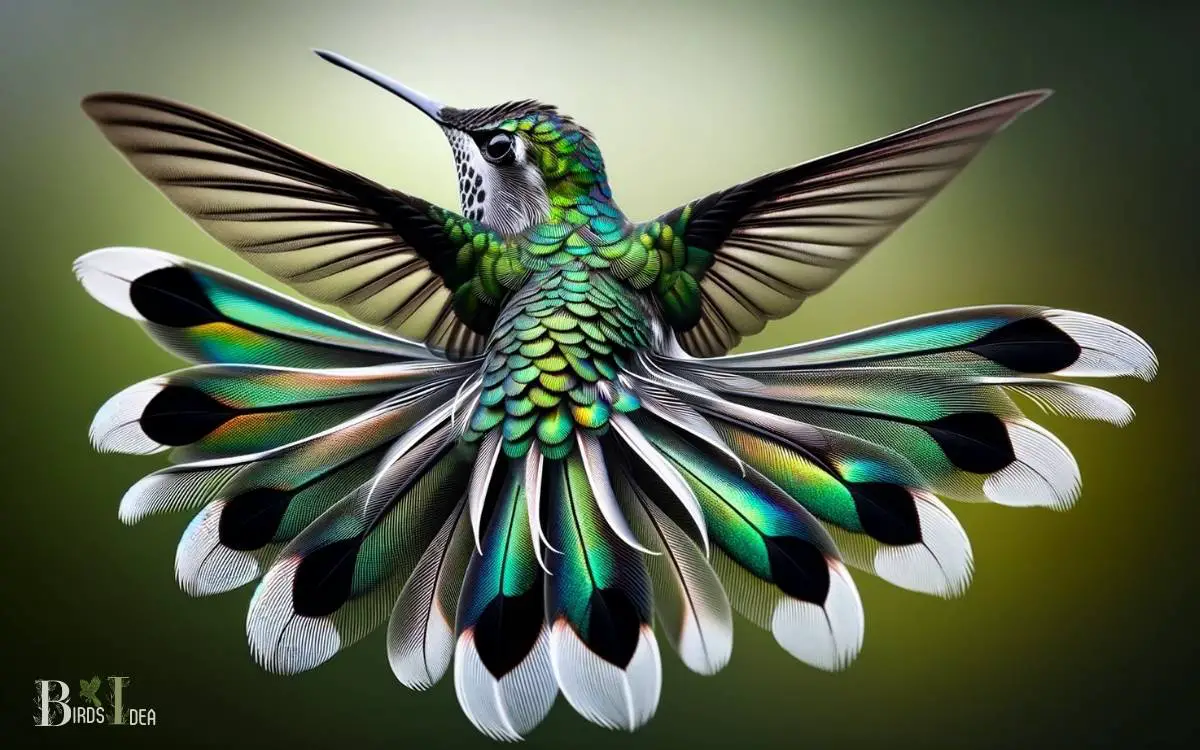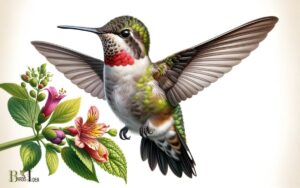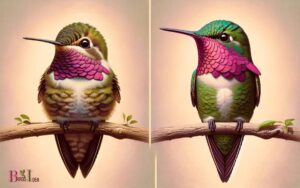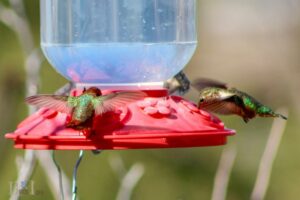Anna’s Hummingbird Tail Feathers: Aerodynamics!
The Anna’s Hummingbird (Calypte anna) showcases a dazzling set of tail feathers that are not only central to its flight abilities but also play a crucial role in its mating displays.
The male’s tail feathers are particularly notable for their iridescent colors and elaborate courtship performance.
Anna’s Hummingbird tail feathers are a marvel of nature, adapted for both function and display:
During the courtship display, the male Anna’s Hummingbird’s tail feathers create a buzzing sound as he dives, which, along with the visual flash of color, appeals to the female’s senses. This combination of auditory and visual cues is critical to their mating rituals.
In the dynamic dance of Anna’s Hummingbird courtship, the male’s radiant tail feathers are his crowning glory, shimmering in the sunlight as he performs his aerial ballet.

Key Takeaway
Anatomy of the Tail Feathers
The anatomy of Anna’s hummingbird tail feathers reveals intricate structural adaptations for agile flight and precise maneuvering. These feathers are incredibly lightweight yet remarkably strong, allowing for rapid and precise aerial movements.
The central shaft, or rachis, of each tail feather is highly rigid, providing stability during flight. The vanes, or barbs, on either side of the rachis are interlocked with tiny hook-like structures called barbules, creating a smooth and cohesive surface that minimizes air resistance.
Additionally, the shape and arrangement of the tail feathers contribute to the bird’s ability to hover, dart, and make sudden turns with exceptional control.
Understanding the detailed anatomy of these specialized feathers offers insight into the remarkable flight capabilities of the Anna’s hummingbird, which will be further explored in the subsequent section about iridescence and coloration.
Iridescence and Coloration
The iridescence and coloration of Anna’s hummingbird tail feathers are a result of intricate feather coloration mechanisms. Iridescence, a phenomenon seen in bird feathers, is a result of light interacting with specialized feather structures, creating a shimmering effect.
In the case of Anna’s hummingbird, the vibrant and iridescent tail feathers play a significant role in courtship displays, aiding in attracting potential mates.
Feather Coloration Mechanisms
Feather coloration mechanisms, such as iridescence and coloration, play a crucial role in the visual display of Anna’s Hummingbird tail feathers.
Iridescence is the result of light interference caused by the microscopic structure of the feathers, creating a shimmering effect as the bird moves.
On the other hand, coloration is due to pigments in the feathers, producing a wide range of vibrant hues.
Both mechanisms contribute to the stunning visual appearance of Anna’s Hummingbird tail feathers, enhancing their attractiveness during courtship displays and territorial defense.
The following table summarizes the key aspects of iridescence and coloration in Anna’s Hummingbird tail feathers:
| Aspect | Iridescence | Coloration |
|---|---|---|
| Mechanism | Light interference due to microstructure | Pigments in the feathers |
| Visual effect | Shimmering effect as the bird moves | Produces vibrant hues |
| Function | Attractiveness during courtship displays | Visual display during territorial defense |
Iridescence in Bird Feathers
In the context of Anna’s Hummingbird tail feathers, the iridescence in bird feathers is a result of light interference caused by the microscopic structure, contributing to their visually stunning appearance.
Iridescence in bird feathers is primarily due to the presence of melanosomes, which are pigment-containing organelles, and the microstructure of the feather barbules.
This microstructure consists of layers of keratin that create a diffraction grating, scattering and reflecting light at specific wavelengths. The interference of light waves produces the shimmering, changing colors characteristic of iridescence.
This optical phenomenon is not based on pigments, but on the physical structure of the feathers. The iridescent colors play a key role in courtship displays, as they are visually striking and can signal the health and genetic quality of the bird.
Consequently, iridescence in bird feathers is an important aspect of their reproductive behavior.
Role in Courtship Displays
Iridescence and coloration play a crucial role in courtship displays for Anna’s Hummingbird tail feathers.
The vibrant iridescence and striking coloration of Anna’s Hummingbird tail feathers are integral to their courtship displays.
The iridescent feathers reflect and refract light, creating stunning visual displays that are used to attract mates and establish dominance.
The following table illustrates the specific colors and iridescence patterns present in Anna’s Hummingbird tail feathers:
| Feather Color | Iridescence Pattern |
|---|---|
| Green | Metallic shimmer |
| Red | Iridescent flashes |
| Black | Iridescent sheen |
| Blue | Intense iridescence |
These exquisite feather traits are highly valued by potential mates, and the vibrant displays they create play a significant role in the mating rituals of Anna’s Hummingbirds.
Role in Courtship Displays
The iridescent quality of the Anna’s Hummingbird’s tail feathers plays a crucial role in courtship displays, attracting potential mates with its shimmering visual display.
During courtship, male Anna’s Hummingbirds perform intricate aerial displays, showcasing their iridescent tail feathers to females. The shimmering iridescence is a result of the microscopic structure of the feathers, which refracts light, creating stunning visual patterns.
These displays are a key component of the courtship ritual, allowing males to demonstrate their genetic fitness and vitality to potential mates. The ability to produce vibrant, iridescent colors indicates the bird’s health and suitability as a mate.
The courtship displays also serve as a means of communication, allowing males to convey their readiness to mate and their ability to provide for potential offspring.
Territorial Defense Strategies
An important aspect of territorial defense strategies for the Anna’s Hummingbird is the establishment and maintenance of boundaries through aggressive behavior.
These small but feisty birds employ various tactics to protect their feeding and nesting territories from intruders:
- Aerial displays: Anna’s Hummingbirds perform impressive aerial acrobatics to deter rivals, including steep dives, sudden stops, and mid-air chases.
- Vocalizations: They produce sharp chirping sounds to assert their territorial claims and warn intruders.
- Physical confrontations: When verbal and visual cues are not sufficient, these hummingbirds engage in physical combat, using their sharp bills and claws to fend off trespassers.
Feeding and Foraging Adaptations
Adaptations for feeding and foraging in Anna’s Hummingbirds have evolved over time to maximize their efficiency in obtaining nectar and small insects.
Their specialized beak and long, extendible tongue allow them to reach deep into flowers to access nectar, while their rapid metabolism enables them to consume up to half their body weight in food each day.
Anna’s Hummingbirds are also adept at catching small insects in mid-air, using their exceptional agility and precise aerial maneuvering. Their ability to hover and fly in any direction allows them to forage in areas with high floral density.
Additionally, they have developed the skill of accessing a wide variety of flowers, enabling them to adapt to changes in their environment. These feeding and foraging adaptations are crucial for their survival and reproductive success.
Conservation and Threats
The conservation of Anna’s Hummingbird is increasingly important due to the loss of habitat caused by urban development. This species is particularly vulnerable to the effects of climate change, which can disrupt their breeding patterns and food sources.
Understanding and addressing these threats is crucial to the long-term survival of the Anna’s Hummingbird population.
Loss of Habitat
Loss of habitat poses a significant threat to the conservation of Anna’s Hummingbird tail feathers.
Habitat loss due to urbanization, deforestation, and climate change directly impacts the availability of suitable nesting and foraging sites for the Anna’s Hummingbird, leading to adverse effects on their feather health and condition.
- Urbanization: Expansion of urban areas results in the destruction of natural habitats, reducing the availability of suitable environments for hummingbirds.
- Deforestation: Clearing of forests for agricultural and developmental purposes diminishes the natural habitats essential for the survival of Anna’s Hummingbirds.
- Climate Change: Alterations in climate patterns can disrupt the availability of nectar-producing plants and insects, crucial food sources for the hummingbirds.
Efforts to address habitat loss through conservation measures are essential for the long-term preservation of the Anna’s Hummingbird and its distinct tail feathers.
Urban Development Impact
Urban development poses both conservation challenges and threats to the preservation of Anna’s Hummingbird tail feathers.
As urban areas expand, natural habitats are destroyed or fragmented, leading to a loss of suitable nesting sites and food sources for these hummingbirds.
Additionally, urban development introduces new threats such as pollution, collisions with buildings, and competition with invasive species.
However, conservation efforts can mitigate these impacts. Creating green spaces within urban environments, implementing bird-friendly building designs, and educating the public about the importance of preserving natural habitats can all contribute to the protection of Anna’s Hummingbird populations.
| Conservation Challenges | Threats |
|---|---|
| Habitat Loss | Pollution |
| Fragmentation | Building Collisions |
| Reduced Resources | Invasive Species |
| Nesting Site Depletion | Habitat Competition |
| Urbanization Effects | Altered Behavior |
These efforts are essential for ensuring the survival of this iconic species in the face of ongoing urban development.
Climate Change Effects
Amidst the escalating threat of climate change, the conservation of Anna’s Hummingbird tail feathers necessitates heightened attention to mitigate the impact on their natural habitats and overall population.
Climate change poses several significant challenges to the survival of Anna’s Hummingbirds, including:
- Shifts in Habitat Availability: Changing temperatures and precipitation patterns may alter the availability of suitable nesting and foraging sites for Anna’s Hummingbirds.
- Altered Flowering and Nectar Availability: Climate change can disrupt the timing of flowering plants, affecting the availability of nectar, a crucial food source for hummingbirds.
- Increased Frequency of Extreme Weather Events: More frequent and severe weather events, such as storms and heatwaves, can directly impact the survival and reproductive success of Anna’s Hummingbirds.
Conservation efforts must address these threats to ensure the long-term survival of this iconic species.
Conclusion
The anatomy and iridescence of Anna’s hummingbird tail feathers play a crucial role in courtship displays, territorial defense strategies, and feeding adaptations. These specialized adaptations have allowed the species to thrive in its natural habitat.
However, conservation efforts are necessary to protect the species from threats such as habitat loss and climate change. The Anna’s hummingbird’s tail feathers serve as a vibrant symbol of resilience and adaptation in the face of environmental challenges.






